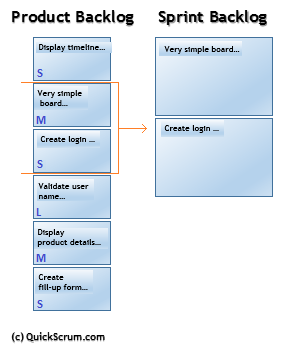In a Scrum project, the Sprint planning meeting agenda is one of the most important activities undertaken by the team. The product owner plays an important part in the agenda. In Scrum, out of the many important duties carried out by a PO, a very important one is to create the product backlog based upon the vision of the stakeholders, and subsequently maintain or “groom” it with the help of team members (preferably). However, once the backlog is created and all required product backlog items are properly defined in it, it becomes necessary to “prepare” for the next step in the Agile product development cycle – plan and develop effective sprints so shippable user stories are delivered at the end of sprint cycles. Offering consistent development over successive sprint iterations is an inherent feature of Agile Scrum. In a sprint planning agenda, the objective of a sprint meeting is to prepare productive sprints so the team can develop meaningful stories.
So, what does a sprint planning meeting actually consist of? In practice, the meeting is conducted in two parts – the first part is dominated by the product owner while in the second part the development team actually prepares tasks from user stories taken up for development in the sprint backlog.
1st part of sprint planning
The product owner is the most “conversant” person as far as user stories are concerned since he or she actually “creates” the product backlog. The stories need to be explained to the team members. During the first part of the Scrum sprint planning meeting, the PO selects some of the most important product backlog items from the top of the backlog, and creates a “sprint backlog” by transferring the selected stories into it. So, the sprint backlog is a subset of the main backlog, and contains a “chunk” of stories which carry high business values. The PO explains how the development of a particular story should be carried out by the development team. The acceptance criteria is explained and the team is briefed regarding what it should do to ensure their “development” is shippable i.e. the stories are bug free and satisfy the benchmarks or acceptance criteria linked with each story. The PO also answers any doubts or queries put up by the team.

The first part is attended by the entire team – the product owner, scrum master, and the development team members. It is not necessary for the stakeholders and project owners to attend the meeting, but if they desire to do so, they can attend the meeting as “passive” invitees, and not disturb the proceedings with their suggestions or even try to get “involved” in the meeting.
2nd part of sprint planning
User stories form the base of all development activity in Scrum. The entire product is developed by creating shippable stories, which are later integrated to “form” the complete product. During the second part of the Scrum planning meeting, the team starts discussing how it will carry out the actual development activity and create the stories in the sprint backlog. Generally, a Scrum team is “multi-talented” i.e. each team member possesses more than one type of expertise. However, it is important to know that this may not always be the case in all Scrum projects, since the product requirements and resources may vary depending upon the nature of product to be developed.
The team members – developers, programmers, designers, QA personnel, and technical writers – decide amongst themselves how the user stories should be split up into parts that are more “manageable”. Each such “part” is referred to as a “task” in Scrum. Tasks are developed to create shippable user stories. A developer can develop each task individually. Certain Scrum teams may even work in “pairs”. Members collaborate, and decide amongst themselves as to who should take up which task depending upon the experience and levels of expertise possessed by them. Once the tasks are “distributed” the actual sprint can begin.Read more at
No comments:
Post a Comment